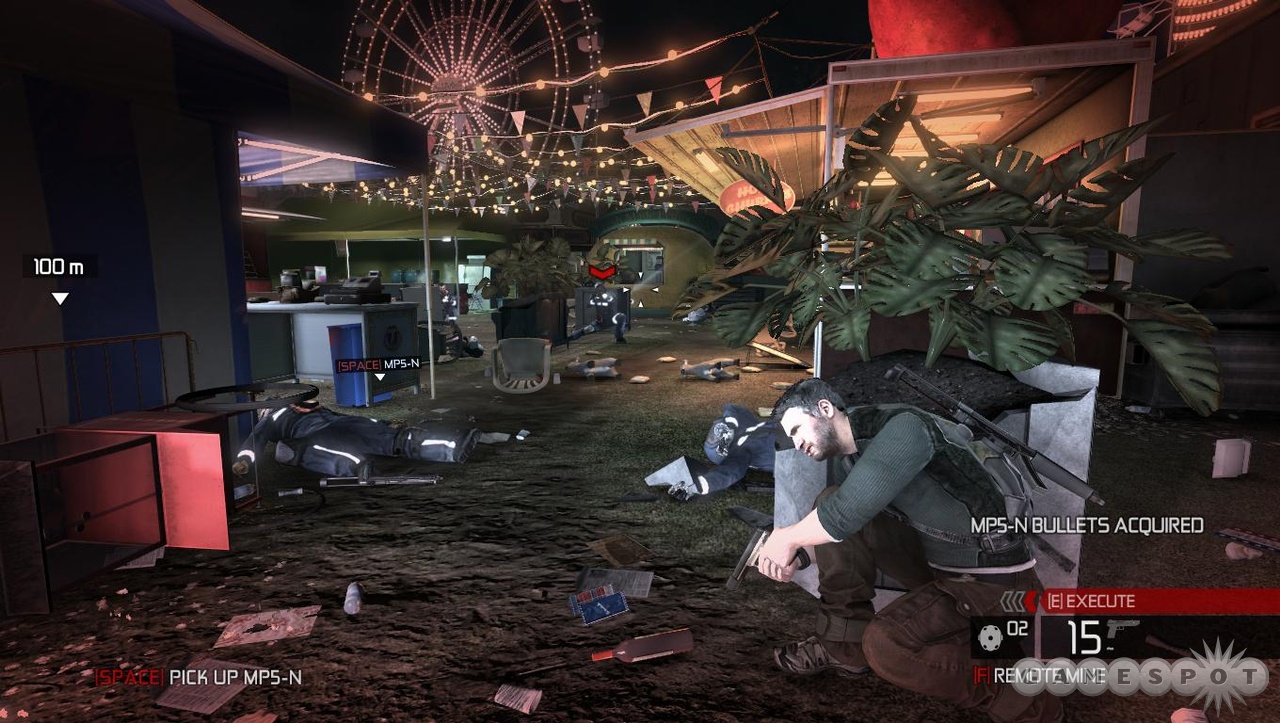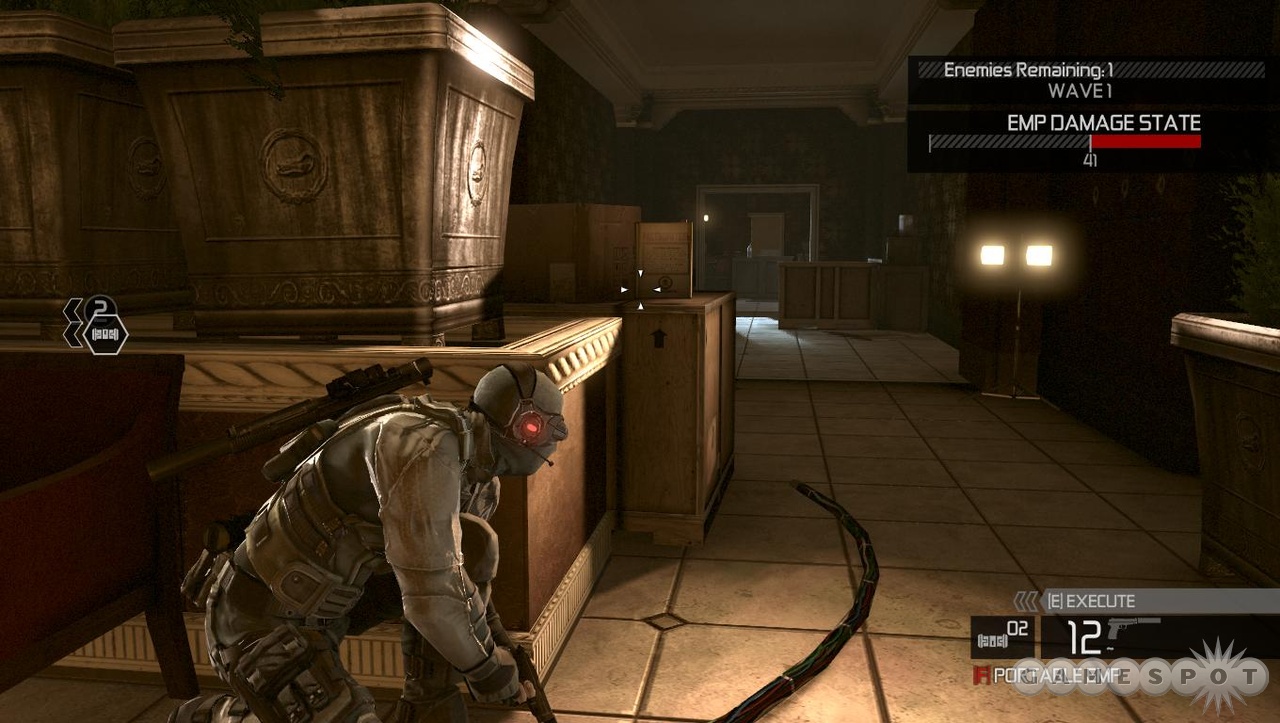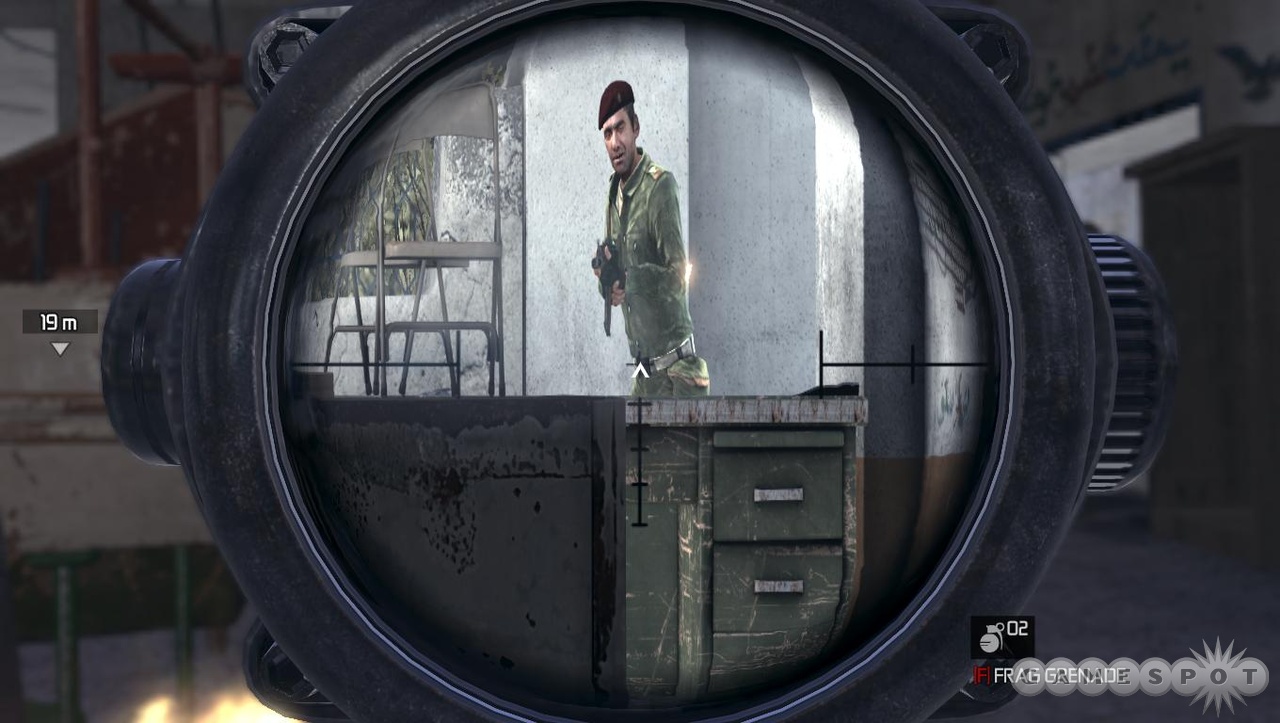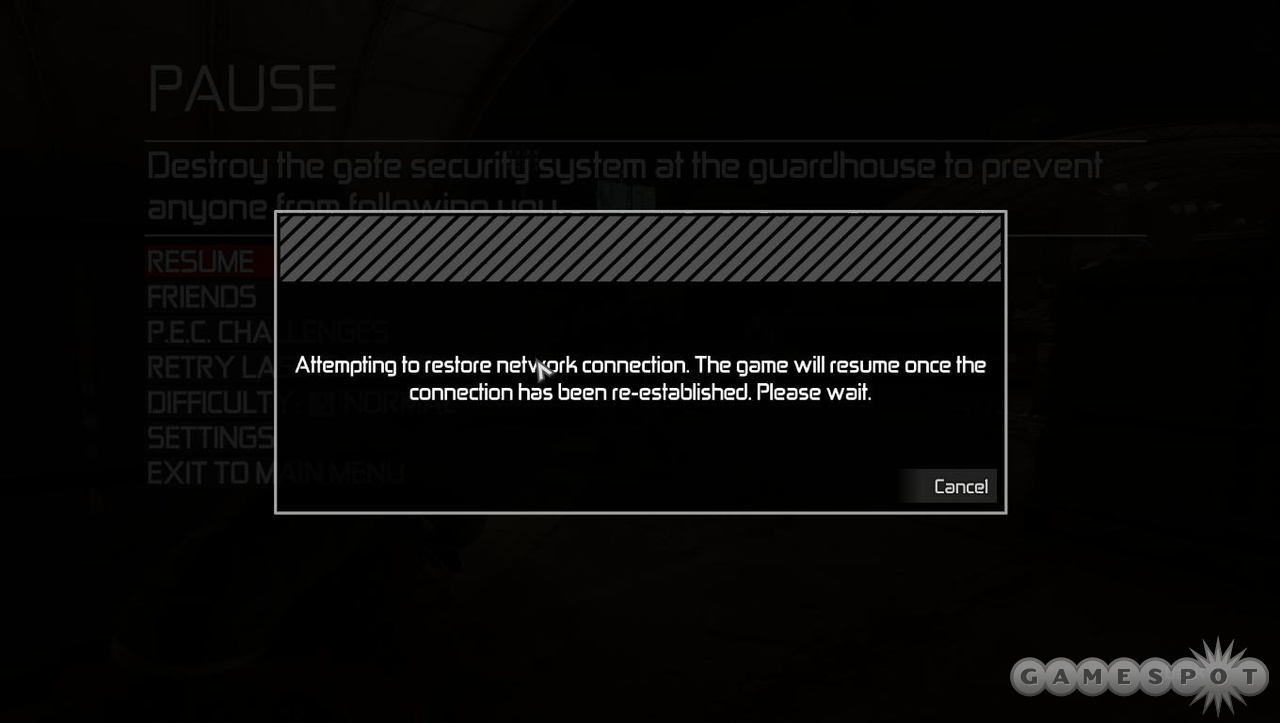Sam Fisher is mad--and after playing the PC version of Splinter Cell: Conviction, you might feel a little cranky too. Conviction tells Sam's conspiracy-driven story in a brilliant way, and its slick execution moves are fun to perform, particularly in the game's cooperative mode. Unfortunately, these sharp strengths are dulled by a number of issues that will have PC players feeling like second-class citizens. The co-op play that made the Xbox 360 version a winner is seriously injured here due to the mind-boggling omission of voice and text chat, and the precision of the keyboard and mouse controls dissolve much of the tension the short campaign tries to generate. Glitches and bugs, some related to Conviction's stringent online-only copy protection, also undercut the goodwill the game's memorable moments inspire. All of this white noise obscures the great game lurking behind it, making Conviction the latest console-to-PC port that fails to do its platform justice.
Sam Fisher is the gravel-voiced protagonist who is as much a part of Splinter Cell's identity as goggles and guns. The murder of his daughter Sarah has siphoned away the hope and joy in Sam's life, and he's left with a single focus: find her killer. A few old friends put Sam on the trail, but that trail isn't a straightforward one (is it ever?), and Sam soon finds himself wrapped up in a conspiracy far greater than it first appears. You encounter a few legitimate surprises along the way, though the story isn't as intriguing as the way in which it is told. The text of your current mission is stretched across walls and angled up pipes, as are simple indications of Sam's emotional state. ("Anger," indicates one display; "Guilt," shows another.) Black-and-white flashbacks play out on certain surfaces as if someone is broadcasting Sam's thoughts through an old movie projector. This environmental integration is remarkably effective, broadcasting updates and emotional states as if they are burned into his soul and then etched directly onto his retinas. Actor Michael Ironside again does a good job as Sam; some scenes are thick with his desperation and exasperation. The supporting cast keeps up with him, making it easy to identify with the old acquaintances that have his back.
That something has changed is clear from the moment you lead Sam through the initial level. Sam can still crouch and slink of course, but Conviction's stealth is centered around its cover system. You can take cover and press against any vertical surface easily, from walls and curbs to vehicles and filing cabinets. You may then slip quickly to the next cover spot, assuming the visual indicator appears at the cover spot you want to zip to next. It's an intuitive system, and you can use it to quickly position yourself in all the right ways, often so you can clock a wandering guard over the head as he passes by without being seen by his cohorts in crime. You get some good interface tools to help you get your bearings when trying to stay out of sight. If you're shrouded in darkness and invisible to your enemies, everything turns black and white, aside from targets and important environmental objects. If you're seen, a ghostly image of your form will remain at your last known location, and the AI will direct its attention there. Warning alerts appear and sound if you are caught or are in immediate danger of being caught. The black-and-white effect can obscure things a bit much sometimes, but overall, these are sensible interface elements that toss you important information with a minimum of distraction.

But you won't spend as much time in the shadows in Conviction as you did in previous games. Sam is still vulnerable; you can't just wander into a horde of hired guns in broad daylight. But in Conviction, Sam conducts business on his own terms and is therefore far more aggressive than before. To this end, you can mark multiple enemies at once (up to four, depending on which weapon you're packing and whether you've upgraded it) and then execute them in a single move. To pull off a mark-and-execute maneuver, you first have to perform a close-quarters kill. Once you've taken down your initial target, the execution is ready, and as long as each of your targets is in range and not obscured by some object or another (you know it's a go when the tag markers turn red), all you need to do is press a single button. Time slows a bit, the camera zooms toward each enemy in turn with a subtle swoosh, and your victims crumple to the ground, no match for a trained killing machine with a chip on his shoulder. It's a little disconcerting when a target moves behind a wall during an execution and your bullet clips right through it, but as a rule, the slick camera moves and audio cues make executions fun to pull off. In fact, most of the campaign's best moments come from clever use of execution tactics. For example, a roomful of guards aware of your presence might be flanking your location. Some quick marking, a slick hand-to-hand murder, and a zoom-zoom-zoom execution is an effective way of eliminating the threat.
Conviction tries its hand at other explosive moments, but these don't come together in such a dramatic way. You can occasionally use environmental objects as tools of destruction--shoot a chandelier so that it falls on a foe's head, or shoot an enormous explosive tanker, for example--but the rarity of these opportunities makes the scattered few that exist seem like a tease. More of a tease are the few interrogations you perform on key witnesses. In these highly scripted scenes, you grab your target and bash the answers out of him by jamming him into environmental objects clearly waiting to be splattered with blood. Unfortunately, the first interrogation you perform--a bloody bathroom beatdown--is the best in the entire game. In the rest, the invisible walls that hem you in and the "hey, look at me" nature of three or four conveniently placed objects make interrogations more predictable than provocative. Had they been more interactive, they could have been extraordinary; instead, they're violent but shrug-worthy.

Many levels do grant you welcome flexibility in how to approach the task at hand. You might shimmy up a pipe, throw a remote camera (one of a few gadgets for you to use), lure nearby guards to it, and detonate it--always a good way of getting two or three hostiles out of the way. Or perhaps you'll hang from a ledge and use one of your silenced pistols to thin the crowd with a few well-placed headshots. The flexibility is nice, but Splinter Cell: Conviction is remarkably easy. Even with the overzealous mouse smoothing, which makes camera movement feel a little laggy, the keyboard and mouse provide pinpoint precision when compared to an Xbox 360 controller. If you play on normal difficulty, you'll breeze through most levels so easily you might forget you even have gadgets and alternative routes, since you'll never need them. The hardest difficulty level offers more challenge, but even then, Conviction doesn't generate as much tension as you'd expect, given the series' pedigree. And without tension, even the most skillful executions don't offer as much of a rush as you'd want. You can plug in an Xbox 360 controller of course, but you'll need to use the wired variety because the button mapping on wireless controllers is broken and cannot be adjusted.
Splinter Cell: Conviction does go out of its way to throw in other kinds of variety, and fortunately, it hits more than it misses. Many levels, such as an early one in an art-filled mansion, look colorful and may be approached in a number of ways. A jaunt through a fairground, a secure checkpoint surrounded by innocent bystanders, and an excursion through an airfield are also particular highlights, because they offer plenty of room to slink about and prepare some executions. Others don't work out so well, such as a flashback level that removes many of the elements that make Conviction unique and plays out more like an awkward third-person shooter. A level at the Lincoln Memorial includes an exciting chase sequence--but also an overlong eavesdropping session involving a lot of boring dialogue. Nevertheless, most campaign missions play fine, thanks to careful level design and enemies that are quick to flank when they've spotted you, and quick to spread out when doing so puts pressure on you. The AI isn't always spot-on; your adversaries are sometimes slow to respond to grenades tossed directly at their feet, for example. But security contingents are still unpredictable and adaptive, if not exactly threatening.
Conviction is more fun when you add a buddy to the mix. The co-op campaign--a separate story involving a Third Echelon agent and his Russian counterpart--is the game's best feature, due in part to the ability to pull off dual executions. These allow you to perform executions when one target may be in sight of one player but not the other. Perhaps one of you is hanging from a window ledge, while the other silently flanks from within. The two of you might mark your targets in advance, the first player will yank an unsuspecting guard from the window, and the second will trigger an execution. A few seconds later, you've taken out four or five enemies together in a flurry of slow-motion zooms and profane yelps from your victims. It's a shame that these moments occur mostly by accident. Splinter Cell: Conviction supports absolutely no form of player chat. If you want to communicate with your partner, you need to use third-party voice communication software, since none is built into the game. There's no text chat, either, which is an absolutely absurd omission. As a result, co-op matches can feel haphazard, with both players doing their own thing and hoping for the best.

The missing chat in cooperative play isn't the only issue you might encounter when you want to jump into an online match. Co-op matchmaking is currently unreliable. You might have to wait 15 minutes or longer to get into a game, and this issue appears to be widespread. The bugs aren't limited to co-op play, however. Some of those we encountered, such as a dead body getting up and running in place, and stretched visuals when looking through a scope, didn't significantly affect the experience. Others, such as a few crashes to the desktop, were a greater annoyance. We also experienced issues with Ubisoft's copy protection method, which requires players to maintain a consistent Internet connection, even when playing the single-player campaign. On several occasions, Ubi's servers hiccuped multiple times in a row, pausing the game in progress and then restarting a few seconds later in an annoying loop. A few times we couldn't connect to the servers and therefore couldn't play the game.
If you can get past these issues, you might enjoy the remainder of Conviction's co-op offerings. Aside from the co-op campaign, Hunter mode provides the most entertaining two-player experience. Here, you and your partner traverse a map broken up into smaller chunks patrolled by a set number of guards you must eliminate. Silence is golden in this mode, for should either of you get caught, reinforcements rush in, raising the number of enemies you need to take out. What makes this mode interesting is its variety and flexibility. Stealth is ideal, but should you fail to keep to the shadows, you can use your entire bag of tricks with abandon, marking and executing foes as you and your partner see fit. Last Stand is Splinter Cell: Conviction's battle-waves-of-enemies mode, in which you defend an EMP generator against the infiltrating hordes. This mode is a challenge once large numbers of more powerful enemies start streaming in, though a touch of predictability lessens the impact. Guards might flow through a single doorway en masse, allowing you and your partner to dramatically reduce their numbers with a few grenades and mines. Last Stand veers from the stealth that makes the other modes so unique, yet it still offers some short-lived fun, and the smooth difficulty curve as you move from one wave to the next provides momentum.

Face-Off is the only competitive mode, and the least interesting of the multiplayer options. Here, you and a single opponent attempt to take down roaming guards, as well as each other, while accumulating points for kills. It's satisfying to identify your opponent without being seen and to take him out as you would any other foe, particularly if you're sneaky about it. But the competitive nature of this mode eliminates dual executions and chokehold escapes, the very facets that make the other modes so fascinating. Nevertheless, hunting the most dangerous enemy in the game (an actual human being) gives this mode some urgency, and the lack of in-game chat naturally doesn't hinder competitive play. For what it's worth, you can tackle the co-op maps without a partner through the Deniable Ops menu, and as in the campaign, it's fun to string a few close-quarters kills and multi-enemy executions together.
Conviction looks a bit dated but nonetheless attractive, a likely consequence of the older Unreal 2 technology that brings it to life. Fuzzy textures, some blocky geometry, and some jagged edges betray the engine's age, yet you get the sense that developer Ubisoft Montreal squeezed a good deal out of it. Smart use of color versus the deepness of the black-and-white stealth effects makes certain environments, such as a carnival outside the Washington Monument, really stand out. It's best not to look too closely at the grainy textures when traversing war-torn streets, but the abandoned vehicles strewn about and a decrepit-looking fuel station make the dusty level feel uncomfortably--and appropriately--hostile. It's surprising that the game doesn't perform better. On PCs that exceed the recommended system requirements, Conviction is prone to frame rate dips and the occasional stutter. Even the overly compressed cinematics suffer from similar frame rate jitters when the camera pans across the environment.

The soundtrack deserves special mention. You won't walk away humming any tunes--this isn't that kind of music--but it's impressive for how well its electronic pulses, trembling violins, and hi-tech warbles weave in and out of the action. You won't notice it often, but that's what makes it so effective: it enhances the tension without overwhelming it. Sound is an important part of Splinter Cell: Conviction. Guards will consistently taunt you when they are aware of your presence, even reminding you of the actions you took in previous missions. In fact, those reminders are so frequent that they get predictable after a while; it's a contrived dialogue trick that doesn't immerse you so much as it calls attention to its own cleverness, especially considering that the same voice actor was clearly used to record so many of the lines. But you sometimes rely on those calls to warn you of approaching guards, and you'll appreciate many subtle details in the audio, from the squeal of your sonic goggles when you turn them on, to the subtle whines of nearby security cameras.
It's a shame that the PC version of Splinter Cell: Conviction doesn't deliver on its potential. Stellar storytelling and slick executions lead to some enjoyment, but other facets of the game come across as careless. Co-op play without player communication; uneven performance; copy protection that leads to noticeable in-game frustrations--these and other elements distract from what should have been a great game. That it retails for $10 more than a typical PC release makes these flaws seem even more egregious. The issues won't make you as angry as Sam Fisher, but they will make you wish that this version of Conviction had been given the loving care it deserved.